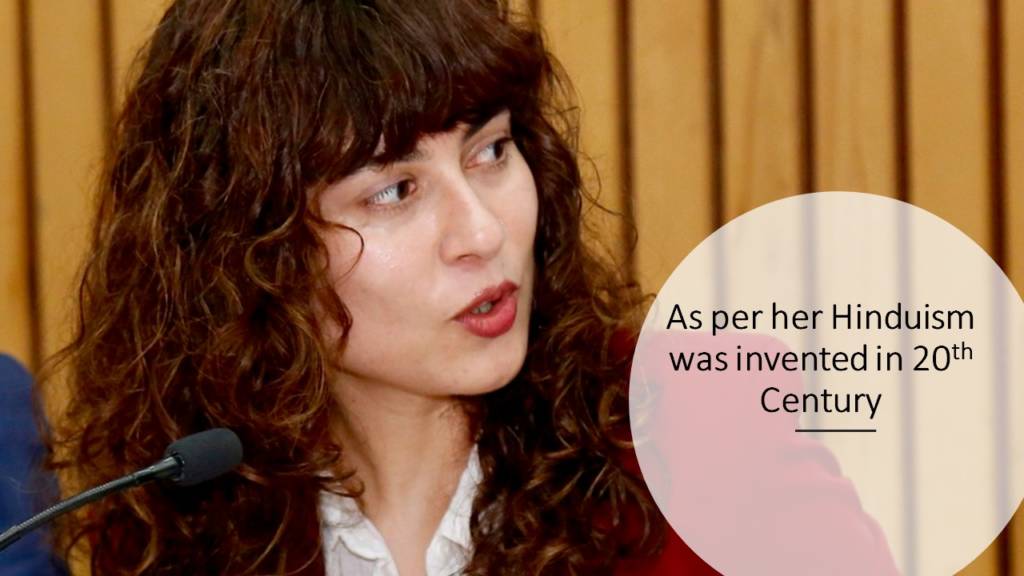Today, in the era of modernity, social media is a powerful tool or weapon where the left-liberals are exposed every day. Not only their agenda but also their deracinated minds and half-knowledge is exposed every time with the help of which they have been presenting the gallimaufry of history, philosophy and culture of India. Another name was added to this episode and that was Divya Dwivedi, an IIT Delhi professor.
On a debate show on NDTV, on the topic of “Reclaiming Gandhi for our times”, Divya Dwivedi said in frigid English that “Hinduism was invented in the 20th century”.
https://twitter.com/ndtv/status/1180174865522806784
Now it is clear from this statement how deep Divya Dwivedi’s knowledge about Hindus and Sanatana Dharma is, and also how much knowledge Divya Dwivedi has of Indian culture, which she has been claiming on a mainstream media channel of the country confidently.
Now, when it comes to ‘Hindu’ and ‘Hinduism’, it is necessary to know that foreign historians were surprised to see India’s civilization and Sanatan Dharma and tried to encapsulate it into a definition by defining it according to their western lens of ideas and religion, and naming it as Hinduism. It is nothing but a rigid western concept imposed on India by the West in the 18th century. The ‘Hindu’ or ‘Indian’ civilization is not based on an idea just like the West. If Bharatiya or Sanatan Dharma is still moving forward then it’s due to its plurality.
The greatest strength of Hinduism is its flexibility, its tendency to adapt and change. If you believe in god, you are a believer, if you do not believe then you are an atheist, if you believe in the shape of God, then you can adopt the Saguna Brahman path if you believe that God is formless and omnipresent, and then you can adopt Nirguna Brahman. If Shiva is considered to be superior, Shaiva is the way, Vishnu is considered to be superior, Vaishnav is the way, Shakti is considered to be superior then Shakt is the way. Finally, if you consider all of them equal, you can worship everyone. If you have to understand the methods and ideas, then you have to know the Vedas, if you want to know the significance of Sanatan Dharma, then you have the Upanishads, if you want to understand in the form of story, then there is the Puranas, if you want to understand in the form of epic, then there is Mahabharata and Ramayana, if you want to understand the path of karma, then you have to go on pilgrimage.
There is a temple in every street, there is Char Dham, there is Shaktipeeth, there is Jyotirlinga and if you do not want to go to either of the places then only a small place of worship can become your shrine. There are mantras to read, formulas to understand and hymns to sing.
Even after so much diversity, if someone names it ‘Hinduism’, then it only shows their colonial mentality and their language’s inability that has no words for this diverse form of Sanatan Dharma.
Now, coming to history. Even today, there is a dispute about how old this Indian civilization or the Sarasvati civilization is? Western historians declared this civilization as the Indus Valley which they described with their limited knowledge and declared it to be only 3519 years old from today. However, as technology continues to develop, this civilization of India is being found older than anticipation. It is neither started nor defined by any one person, therefore, to consider it as starting from a date is an insult to this eternal civilization. Many elements of Saraswati civilization come from the pre-Vedic culture such as fire, mother-goddess, worship of trees and animals, oil lamps, use of red pigment, conch, rituals through water, purification and most importantly, yoga and meditation. Therefore, even guessing the date of the composition of Vedas is a difficult task.
After an unsuccessful try of understanding this Sanatan civilization of India, Western scholars compared Sanatan Dharma to the Abrahamic religion of Europe and Central Asia. They tried to limit the entire eternal and diverse knowledge and civilization to just one holy book or idea. This has never been the way of this Sanatan Dharma.
Sanatan dharma is open dharma which has developed not from thought but from conscience. The literal meaning of Sanatan is well known. It generally means ‘one who has always existed’, that is, no one has any concern with the origin and birth and is an object or person or principle.
This is dharma or way of life like Ajnma, whose stream of development has been continuous. It is a continuous flow of conscience, a simple way of life, as vast and deep as the ocean. Neither the beginning nor the end, indestructible, is invincible and constant like that Atman.
Similarly, the five elements i.e. sky, air, water, fire, and earth also fall under the category of eternal truth because they change their form but never end and the dharma which shows the path of this truth is eternal.
But the left Liberals compare Sanatan Dharma to other religions for their agenda and they are also bound by western ideas. Now, in such a situation, if a professor of an institute like IIT goes to a channel and tells that Hinduism was invented in the 20th century, then it is a failure of educational institutions of India. These Macaulay’s disciples should also read the original history of India before making any kind of comment on Sanatan Dharma. Sanatana Dharma is much deeper and deeper than the limited study on the basis of Western definition.
